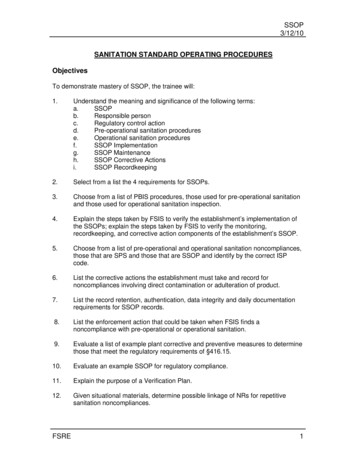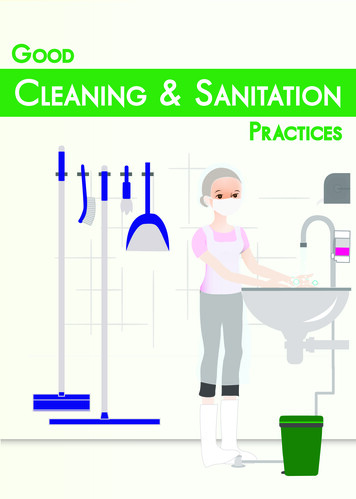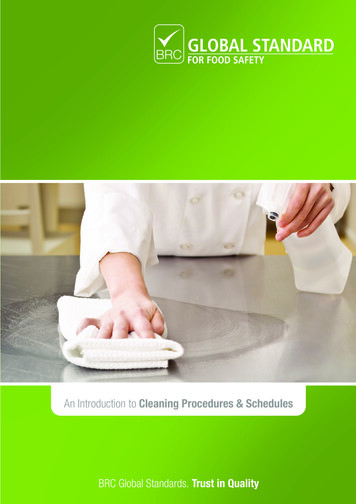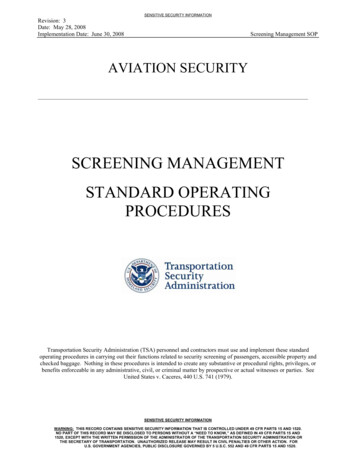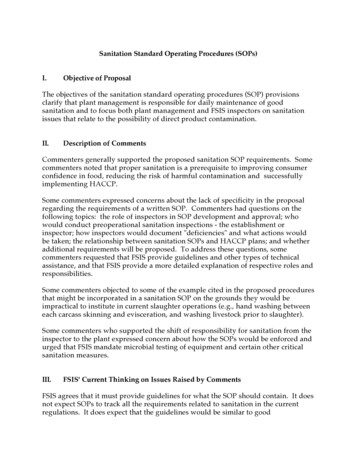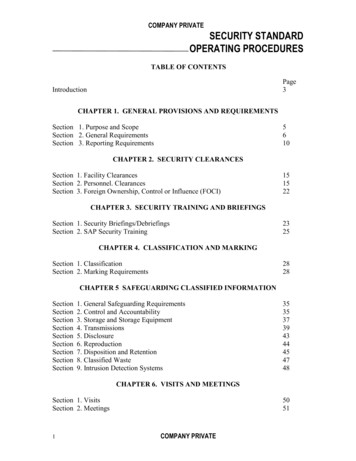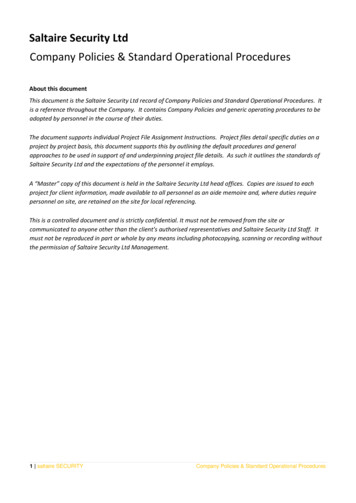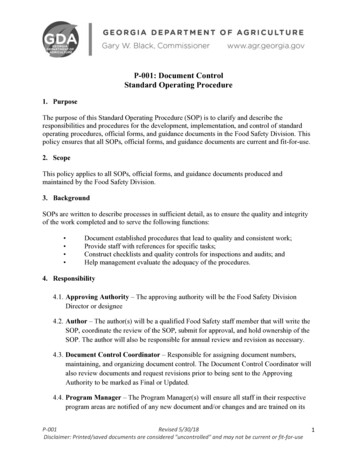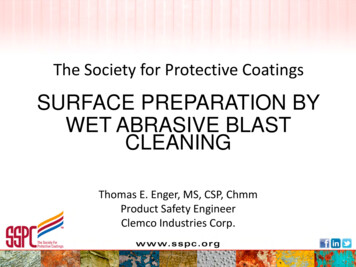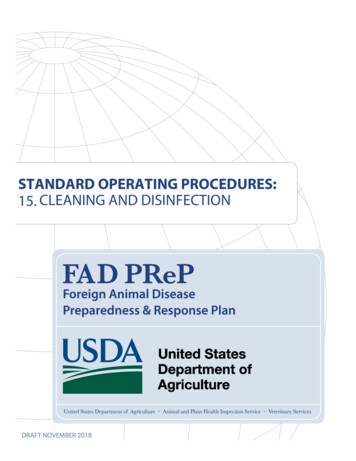
Transcription
STANDARD OPERATING PROCEDURES:15. CLEANING AND DISINFECTIONDRAFT NOVEMBER 2018
The Foreign Animal Disease Preparedness and Response Plan (FAD PReP) Standard OperatingProcedures (SOPs) provide operational guidance for responding to an animal health emergencyin the United States.These draft SOPs are under ongoing review. This document was last updated in November2018. Please send questions or comments to:National Preparedness and Incident Coordination CenterVeterinary ServicesAnimal and Plant Health Inspection ServiceU.S. Department of Agriculture4700 River Road, Unit 41Riverdale, Maryland 20737Fax: (301) 734-7817E-mail: FAD.PReP.Comments@aphis.usda.govWhile best efforts have been used in developing and preparing the FAD PReP SOPs, the U.S.Government, U.S. Department of Agriculture (USDA), and the Animal and Plant HealthInspection Service and other parties, such as employees and contractors contributing to thisdocument, neither warrant nor assume any legal liability or responsibility for the accuracy,completeness, or usefulness of any information or procedure disclosed. The primary purpose ofthese FAD PReP SOPs is to provide operational guidance to those government officialsresponding to a foreign animal disease outbreak. It is only posted for public access as a reference.The FAD PReP SOPs may refer to links to various other Federal and State agencies and privateorganizations. These links are maintained solely for the user’s information and convenience. Ifyou link to such site, please be aware that you are then subject to the policies of that site. Inaddition, please note that USDA does not control and cannot guarantee the relevance, timeliness,or accuracy of these outside materials. Further, the inclusion of links or pointers to particularitems in hypertext is not intended to reflect their importance, nor is it intended to constituteapproval or endorsement of any views expressed, or products or services offered, on theseoutside websites, or the organizations sponsoring the websites.Trade names are used solely for the purpose of providing specific information. Mention of atrade name does not constitute a guarantee or warranty of the product by USDA or anendorsement over other products not mentioned.USDA prohibits discrimination in all its programs and activities on the basis of race, color,national origin, sex, religion, age, disability, political beliefs, sexual orientation, or marital orfamily status. (Not all prohibited bases apply to all programs.) Persons with disabilities whorequire alternative means for communication of program information (Braille, large print,audiotape, etc.) should contact USDA’s TARGET Center at (202) 720-2600 (voice andtelecommunications device for the deaf [TDD]).To file a complaint of discrimination, write USDA, Director, Office of Civil Rights, Room326-W, Whitten Building, 1400 Independence Avenue SW, Washington, DC 20250-9410 or call(202) 720-5964 (voice and TDD). USDA is an equal opportunity provider and employer.SOP ManualiiCleaning and Disinfection
Contents15.115.215.315.415.5Introduction . 15-115.1.1 Cleaning and Disinfection/Virus Elimination Overview . 15-115.1.1.1 Definitions . 15-215.1.2 Goals . 15-215.1.2.1 Preparedness Goals . 15-215.1.2.2 Response Goals . 15-215.1.3 Guidelines . 15-215.1.4 Coordination . 15-315.1.5 Assumed Ongoing or Completed Response Activities . 15-3Purpose. 15-4Responsibilities . 15-415.3.1 Overview . 15-415.3.2 Cleaning and Disinfection Personnel Responsibilities . 15-415.3.3 Cleaning and Disinfection Group Supervisor . 15-615.3.4 Site Manager . 15-615.3.5 Cleaning and Disinfection Team Leaders and Team Members . 15-6Cleaning and Disinfection/Virus Elimination Planning . 15-615.4.1 Assessment . 15-615.4.2 Site-Specific Cleaning and Disinfection (Virus Elimination) Plan . 15-715.4.2.1 Outline . 15-815.4.2.2 Review, Design, and Setup of the Premises . 15-815.4.2.3 Selection of Cleaning and Disinfection Methods . 15-915.4.2.4 Selection of Proper Disinfectants . 15-1015.4.2.5 Personnel Requirements . 15-1115.4.2.6 Personal Protective Equipment. 15-1215.4.2.7 Cleaning and Disinfection of Equipment and Supplies . 15-1215.4.2.8 Considerations . 15-1315.4.2.9 Regulatory Permits and Approvals . 15-1415.4.2.10 Site Security and Safety. 15-1415.4.2.11 Quality Assurance/Quality Control . 15-14Cleaning and Disinfection/Virus Elimination Procedures . 15-1515.5.1 Overview . 15-1515.5.2 Cleaning Methods . 15-1615.5.2.1 Dry Cleaning . 15-1615.5.2.2 Wet Cleaning . 15-1715.5.3 Evaluation of the Premises after Cleaning Procedures . 15-1915.5.4 Disinfection Methods . 15-1915.5.4.1 General Disinfectant Mixing Protocol. 15-1915.5.4.2 Wet Disinfection Procedure . 15-2115.5.4.3 Using Heat Treatment for Virus Elimination . 15-2115.5.5 Procedures for Items Unable to be Cleaned and Disinfected . 15-2215.5.6 Procedures for Premises Unable to be Cleaned and Disinfected . 15-2315.5.7 Disposal. 15-23SOP ManualiiiCleaning and Disinfection
15.6Post Cleaning and Disinfection. 15-2415.6.1 Evaluation of the Premises after Disinfection Procedures . 15-2415.6.2 Downtime . 15-24Attachment 15.A Basic Cleaning and Disinfection Equipment and Supplies . 15-25Attachment 15.B Cleaning and Disinfecting Respirators . 15-26Attachment 15.C Disinfecting Slurry Pits . 15-28Attachment 15.D Disinfecting Biohazardous Material Prior to Disposal. 15-30Attachment 15.E Cleaning and Disinfecting Vehicles and Heavy Machinery . 15-32Attachment 15.F Cleaning and Disinfecting Electronic and Euthanasia Equipment . 15-35Attachment 15.G Cleaning and Disinfecting Egg Handling Materials. 15-37Attachment 15.H Cleaning and Disinfecting Tankers, Lines, and Silos for Liquid Egg Products. 15-41Attachment 15.I Egg Products Cleaning-in-Place Log . 15-43Attachment 15.J Foot-and-Mouth Disease Animal By-Products . 15-44Attachment 15.K References and Additional Resources . 15-46Attachment 15.L Abbreviations . 15-47SOP ManualivCleaning and Disinfection
15.1 IntroductionThe cleaning and disinfection (C&D) of equipment, materials, and premises is done to prevent ormitigate the spread of foreign animal diseases (FADs) during an outbreak. As part of a widerresponse, this helps to stabilize animal agriculture, the food supply, the economy, and to protectpublic health and the environment. This standard operating procedure (SOP) provides StateAnimal Health Officials, Animal and Plant Health Inspection Service (APHIS) personnel, andIncident Management Teams (IMTs) with guidance on choosing and using optimal C&Dmethods following an FAD outbreak in domestic livestock and poultry.Several key APHIS documents complement this SOP and provide further detail when necessary.This SOP references the following APHIS documents: Foreign Animal Disease Preparedness and Response Plan (FAD PReP)/National AnimalHealth Emergency Management System (NAHEMS) Guidelines: Biosecurity C&D Disposal Health and Safety Personal Protective Equipment (PPE) Wildlife Management and Vector ControlFAD PReP SOPs: Biosecurity Disposal Health and Safety & PPEAdditional materials may be posted in response to specific disease outbreaks. These documentsare available on the APHIS FAD PReP website: www.aphis.usda.gov/fadprep.15.1.1 Cleaning and Disinfection/Virus Elimination OverviewDuring an FAD outbreak, C&D activities are conducted as a part of regular biosecurityoperations (e.g., to disinfect vehicles) as well as to C&D previously infected premises to preventthe spread of disease and move towards restocking. The latter—the C&D of previously infectedpremises—can also be termed virus elimination. C&D is an effective means of lessening thethreat of animal diseases by reducing the presence of pathogenic microorganisms and preventingthe spread of disease agents. C&D can involve the use of physical, chemical, or biologicalprocesses to remove, inactivate, reduce, or destroy pathogenic microorganisms. Selected C&Dmethods should account for the physical characteristics of the premises and other factors, such asenvironmental conditions, which may influence the effectiveness of virus elimination.SOP Manual15-1Cleaning and Disinfection
15.1.1.1 DefinitionsTable 15-1 lists relevant definitions. Virus elimination refers to the activities that are undertakenafter depopulation and disposal on the premises, to return the premises to a “free” status. C&D,on the other hand, can refer to both activities conducted as part of biosecurity operations(including movement controls), as well as the measures that are conducted during viruselimination procedures.Table 15-1. Cleaning and Disinfection DefinitionsCleaningThe removal of gross contamination, organic material, and debris from the premises orrespective structures, via mechanical means like sweeping (dry cleaning) and/or the useof water and soap or detergent (wet cleaning). The goal is to minimize organic materialso disinfection can be effective.DisinfectionMethods used on surfaces to destroy or eliminate a specific species of infectiousmicroorganism through physical (e.g., heat) or chemical (e.g., disinfectant) means. Acombination of methods may be required.Virus EliminationC&D measures conducted with the primary purpose to destroy or eliminate all viruseson the premises as cost effectively as possible.15.1.2 Goals15.1.2.1 Preparedness GoalsThe preparedness goals for C&D are as follows: Remove, inactivate, reduce, or destroy viruses on Infected Premises. Conduct C&D/virus elimination activities in the most cost effective manner possible. Choose appropriate C&D/virus elimination methods, based on the characteristics of thepremises/houses, temperature, and other relevant factors. Conduct timely and effective initial C&D on all areas of the premises that do not havecontaminated material (this includes vehicles and equipment), prior to final viruselimination activities on the entire premises. Conduct final virus elimination procedures in a timely manner.15.1.2.2 Response GoalsThe response goals for C&D are as follows: Ensure that C&D is conducted on any premises where a disease agent is presumed orconfirmed to exist within 48 hours of disposal of depopulated animals. Remove, inactivate, reduce, or destroy pathogens at infected premises.15.1.3 GuidelinesProper C&D is essential to contain the spread of a disease agent and is an integral part of theeradication plan. Pest control must be completed before C&D can commence. Care must betaken to reduce the generation and dispersal of infective dust and aerosols. If items cannot beSOP Manual15-2Cleaning and Disinfection
adequately cleaned and disinfected, they must be disposed of by other appropriate meansdetermined by the Incident Command.If available personnel or materials are insufficient, Incident Command can request emergency3D (depopulation, disposal, and decontamination) contractor support from the NationalVeterinary Stockpile (NVS).15.1.4 CoordinationKey C&D coordination activities are as follows: Collaborate within the unified Incident Command personnel to develop an effective C&Dstrategy, including issues such as environmental conditions (e.g., relative humidity,temperature, and wind). Determine supply requirements and delivery location, date, and time in collaborationwith the Logistics Section. Arrange facility access and determine personnel requirements with the OperationsSection. Prepare for and organize personnel supplies, equipment, and daily accommodations (e.g.,food, water, and lodging) with the Logistics Section. Establish C&D stations that adhere to biosecurity measures, such as vehicle entry andmovement control checkpoints with the Animal Biosecurity Group. Ensure that C&D and disposal processes are properly conducted with the DisposalGroup. Coordinate with the property owner to ensure a smooth process.15.1.5 Assumed Ongoing or Completed Response ActivitiesThese procedures assume the following outbreak response activities are in progress or have beencompleted before C&D: Disease confirmation―completed/ongoing Movement control―ongoing Quarantine―ongoing Surveillance―ongoing Monitoring, countermeasure use, and vaccination―ongoing Biosecurity procedures―ongoing Security measures and crowd control―completed/ongoing Health and safety procedures―ongoing Effluent and runoff control―ongoing Appraisal and compensation―completedSOP Manual15-3Cleaning and Disinfection
Depopulation―completed/ongoing Disposal―completed/ongoing.15.2 PurposeThis C&D SOP provides U.S. Department of Agriculture (USDA) APHIS Veterinary Services(VS) and other official response personnel with operational guidance on cleaning anddisinfecting procedures for animal health emergency deployments. The guidance in this SOP isrelevant in FAD outbreaks of varying sizes, whether the outbreak is isolated to a single premisesor spans across States to multiple premises, because the Incident Command System (ICS)structure from which this SOP is based is both flexible and scalable. These procedures serve asguidance for response personnel performing C&D activities. If these procedures conflict withState, Tribal, Territorial, or local laws, regulations, or procedures, always follow the laws withinyour jurisdiction.15.3 Responsibilities15.3.1 OverviewThe C&D Group is part of the Operations Section (see Figure 15-1 for an example of the ICSstructure). The C&D Group provides services that are essential to an effective animal healthemergency response by helping control and eliminate the disease agent. This section describesthe responsibilities of C&D personnel as well as the importance of cooperation with theDisposal, Depopulation, and Appraisal Groups. This SOP also addresses the topics of hazardcommunication, exercising biosecurity measures, personnel orientation, and needs assessment.The procedures described in this SOP and the FAD PReP/NAHEMS Guidelines: C&D arepertinent sources of guidance for C&D personnel. Participation in educational sessions andemergency response exercises is recommended to gain additional knowledge of C&D processes,methods, and safety considerations.The Incident Commander oversees all activities (Planning, Operations, Finance/Administration,and Logistics) in large scale incidents involving multiple premises and covering large areas.C&D activities are coordinated and overseen by the unified Incident Management Team from theIncident Command Post. After a C&D Group is established, depending on the incident, the C&DGroup Supervisor may deploy one or more C&D teams to complete response activities. Theseteams may be either Task Force teams or Strike teams depending on incident requirements.15.3.2 Cleaning and Disinfection Personnel ResponsibilitiesIn general, the C&D Group is responsible for the following: Providing input on C&D/virus elimination procedures (for example, technical advice,briefings, and daily reports). Providing technical advice on C&D/virus elimination issues to owners or operators ofInfected or Contact Premises.SOP Manual15-4Cleaning and Disinfection
Coordinating closely with the Logistics Section to secure the necessary equipment andsupplies. Coordinating C&D team activities with other ongoing response activities (such assurveillance, biosecurity, and disposal. Establishing, operating, and maintaining C&D stations as needed, including quarantinedpremises, controlled checkpoints for movement and vehicles, and decontaminationstations. Providing personnel to supervise C&D/virus elimination activities. Scheduling and certifying C&D/virus elimination procedures on affected premises.For more information on the responsibilities of C&D personnel, and for an overview of generalC&D activities, please see the FAD PReP/NAHEMS Guidelines: C&D found at the FAD PRePAPHIS website: www.aphis.usda.gov/fadprep.Figure 15-1. Example of an Incident Command Structure 1Safety OfficerIncident Commander/Deputy IncidentCommanderSafetyCoordinatorLiaison OfficerPublicInformationOfficerAssistant PIOIntelligenceOfficer ng andDisinfectionGroupNote: EPI Epidemiologist, PIO Public Information Officer.The C&D Group falls under the Operations Section (a part of the Disease Management Branch) within the IncidentCommand Structure.1SOP Manual15-5Cleaning and Disinfection
15.3.3 Cleaning and Disinfection Group SupervisorThe C&D Group Supervisor manages the cleaning and disinfecting process for infectedpremises. Responsibilities of this individual include directing and supervising all activities of theC&D personnel. A C&D Group Supervisor should have management and C&D experience inpast incidents, as well as knowledge of animal disease. This position reports directly to theOperations Section Chief, who oversees all of the tactical operations of an incident.15.3.4 Site ManagerOn a single premises, the Site Manager is designated as oversight for daily operations andpersonnel. This individual assists with biosecurity, safety, and is the intermediary between allGroups on-site. The Site Manager is responsible for animal welfare, planning the site timeline,and the coordination of ordering resources. This position maintains communication between theIMT and the property owner regarding operational activity.15.3.5 Cleaning and Disinfection Team Leaders and Team MembersC&D Team Leaders supervise the on-site activities of the C&D team (or C&D teams, dependingon the size and needs of the Infected or Contact Premises). C&D Team Leaders haveresponsibility for one of the specific C&D functions, such as the individual C&D stations orcheckpoints. In a large incident, different C&D Team Leaders may manage the functions ofvehicle disinfection stations, equipment, supplies on quarantined premises (which will includeon-site coordination with the Animal Biosecurity Group), and supervision of premises to becleaned and disinfected. C&D Team Leaders shall ensure C&D operations are performed inaccordance with SOPs and manufacturer’s specifications, including temperature requirements.The number of C&D team members will depend on the characteristics of the premises (numberof buildings, size and separation of buildings, size of the area, sanitary conditions of thepremises, and the time frame with which work can or must be completed). The C&D teamconsists of individuals who are experienced and skilled in C&D/virus elimination procedures andfamiliar with handling cleansers and disinfectants.15.4 Cleaning and Disinfection/Virus Elimination PlanningBefore beginning any C&D/virus elimination procedures, under guidance of the IMT, asituational assessment needs to be performed and a plan established so C&D/virus eliminationresponse can ensure a well-coordinated approach. Proper planning helps to ensure theelimination or reduction of pathogens, prevents further movement of pathogens, and helps toensure the safety of response personnel, animals, and the environment. It also minimizes thepossibility that a lack of resources impedes the C&D/virus elimination process.15.4.1 AssessmentIn the assessment phase, information is gathered to assist with the planning of the C&D/viruselimination response. It includes the following (see Figure 15-2):1. Identifying the FAD to be controlled or eliminated.SOP Manual15-6Cleaning and Disinfection
2. Conducting a situation assessment.a. conduct a property assessment (location of electricity poles and lines, undergroundcables, phone lines, fuse box, and meter);b. identify areas and items requiring specific C&D/virus elimination action;c. identify any potentially hazardous situations; andd. identify the location of drainages and run off destinations.3. Estimating the time frame needed to address the situations.4. Identifying areas requiring specific decontamination action.5. Identifying any potential hazardous situation.Figure 15-2. Assessment and Planning of C&D ProceduresSource: FAD PReP/NAHEMS Guidelines: C&D. Andrew Kingsbury, Iowa State University.15.4.2 Site-Specific Cleaning and Disinfection (Virus Elimination) PlanInformation gathered during the assessment phase helps the C&D Group Supervisor effectivelyplan activities. In consultation with the owner (producer, agent, or designee) and the SiteManager, a site-specific plan is prepared. This plan should also address the details on properdisposal of materials (e.g., gross debris, chemical solutions) in a manner that minimizes thefurther spread of microorganisms that is compliant with Federal, State, Tribal, and localrequirements and law. 2USDA APHIS and Center for Food Security and Public Health (CFSPH). (2014). FAD PReP/NAHEMSGuidelines: C&D. Retrieved from APHIS FAD PReP website: www.aphis.usda.gov/fadprep.2SOP Manual15-7Cleaning and Disinfection
15.4.2.1 OutlineA detailed written C&D/virus elimination plan should include the following: A review, design, and setup of the premises. Definition of the area to be cleaned and disinfected. Identification of appropriate locations for the C&D setup and process, and holding areasfor: vehicles and heavy equipment, personnel, and small equipment. Selection of Environmental Protection Agency (EPA) approved C&D products to beused. Description of proper C&D methods and processes to include: cleaning, disinfecting, and downtime. Personnel requirements and assignments. Materials, supplies, and equipment. Regulatory permits and approvals. Plans for proper disposal of disinfectants and materials. (See the FAD PReP/NAHEMSGuidelines: Disposal and the FAD PReP Disposal SOP). Quality assurance and quality control.15.4.2.2 Review, Design, and Setup of the PremisesDuring the assessment phase, sufficient information is gathered to design and setup the premisesfor effective C&D/virus elimination. This part of the plan should include:1. Selecting the most appropriate sites to conduct disinfection and decontamination forequipment and personnel. (See the FAD PReP/NAHEMS Guidelines: C&D forrequirements to select disinfection and decontamination sites). The chosen locationshoulda. have minimal environmental impact; andb. have adequate drainage per State, local, Tribal and Federal regulations.2. Determining areas on the premises that need C&D/virus elimination. Consider thefollowing, for example, when defining the C&D/virus elimination area:a. Interior and exterior surfaces that need C&D.b. Other structures or items such as fences that need C&D.SOP Manual15-8Cleaning and Disinfection
c. Potential environmental risks for outdoor disinfection.3. Designing and setting up the different stations, to include the following:a. Holding areas, Hot Zone/Exclusion Zone (EZ), Warm Zone/Containment ReductionZone (CRZ), and Cold Zone/Support Zone (SZ) for heavy equipment/machinery.b. Holding areas, Hot Zone/EZ, Warm Zone/CRZ, and Cold Zone/SZ for smallequipment and tools.c. Hot Zone/EZ, Warm Zone/CRZ, and Cold Zone/SZ for personnel wash stations (seeFigure 15-3).d. Adequate privacy for personnel cleaning stations.e. Placement of drainage pits, if needed, that are located away from sensitiveenvironmental areas, such as wetlands or wellhead areas.f. Areas for the placement of items for off-site disposal that require further processingsuch as decontamination and then transport to off-site facilities.g. Placement of items for on-site disposal.Figure 15-3. Biosecurity Control ZonesSource: Dani Ausen, Andrew Kingsbury, Iowa State University.15.4.2.3 Selection of Cleaning and Disinfection MethodsThe plan should also cover the various C&D/virus elimination methods that apply to that specificsite. It must also specify the cleanliness and effectiveness to be achieved and identify thesurfaces and structures to undergo C&D/virus elimination. There are different ways toaccomplish C&D and a combination of methods may be necessary. (See the FADPReP/NAHEMS Guidelines: C&D for guidance on choosing a C&D method.)SOP Manual15-9Cleaning and Disinfection
C&D methods may include steam cleaning or scrubbing by hand; shoveling, vacuuming, or sweeping out bulk materials; the chemical disinfectant to be used and its application (as a gas, liquid, foam, or powder)and whether those materials will be sprayed on; and physical (heat, ultraviolet light, or desiccation).15.4.2.4 Selection of Proper DisinfectantsThe requirements of the incident, specifically, the microorganism of concern, disinfectionmethods, and environmental factors all contribute to the disinfectant selection.USDA APHIS recommends that the selection of the disinfectant and disinfection methodologyshould be based on EPA-registered labels for antimicrobial pesticides (that is, disinfectants). Thelabel will be registered by the EPA either under Federal Insecticide, Fungicide, and RodenticideAct (FIFRA) Section 3 (regular label) or under FIFRA Section 18 (emergency use label). Thedisinfectant is used according to its registered label at the indicated dilution, use sites, applicationmethod, contact time, and cautionary statement against the pathogens specified on the label.In addition, a registered disinfectant may be used according to label indication against pathogensnot listed on the label (under a FIFRA Section 2[ee] exemption) provided that this use is not inconflict with State or local law. The non-label-listed pathogens should be equally or moresensitive to inactivation by the disinfectant than the heartiest pathogen listed on the registeredlabel. The FAD PReP/NAHEMS Guidelines: C&D guidance includes recommendationsregarding generally accepted disinfection practices.Document, in the site-specific plan, the scientific rationale for instituting particular C&Dparameters. (Figure 15-4 displays the susceptibility of different types of microorganisms tochemical disinfectants.)Figure 15-4. Susceptibility of Microorganisms to Chemical DisinfectantsSource: Clint May and Andrew Kingsbury, Iowa State University.SOP Manual15-10Cleaning and Disinfection
If a non-EPA-registered disinfectant is determined to be the most effective, the IMT, IncidentCommand, or other Animal Health Official, must seek approval to use the non-EPA-registereddisinfectant (see the EPA website on seeking exemptions at:http://w
SOP Manual 15-1 Cleaning and Disinfection 15.1 Introduction The cleaning and disinfection (C&D) of equipment, materials, and premises is done to prevent or mitigate the spread of foreign

